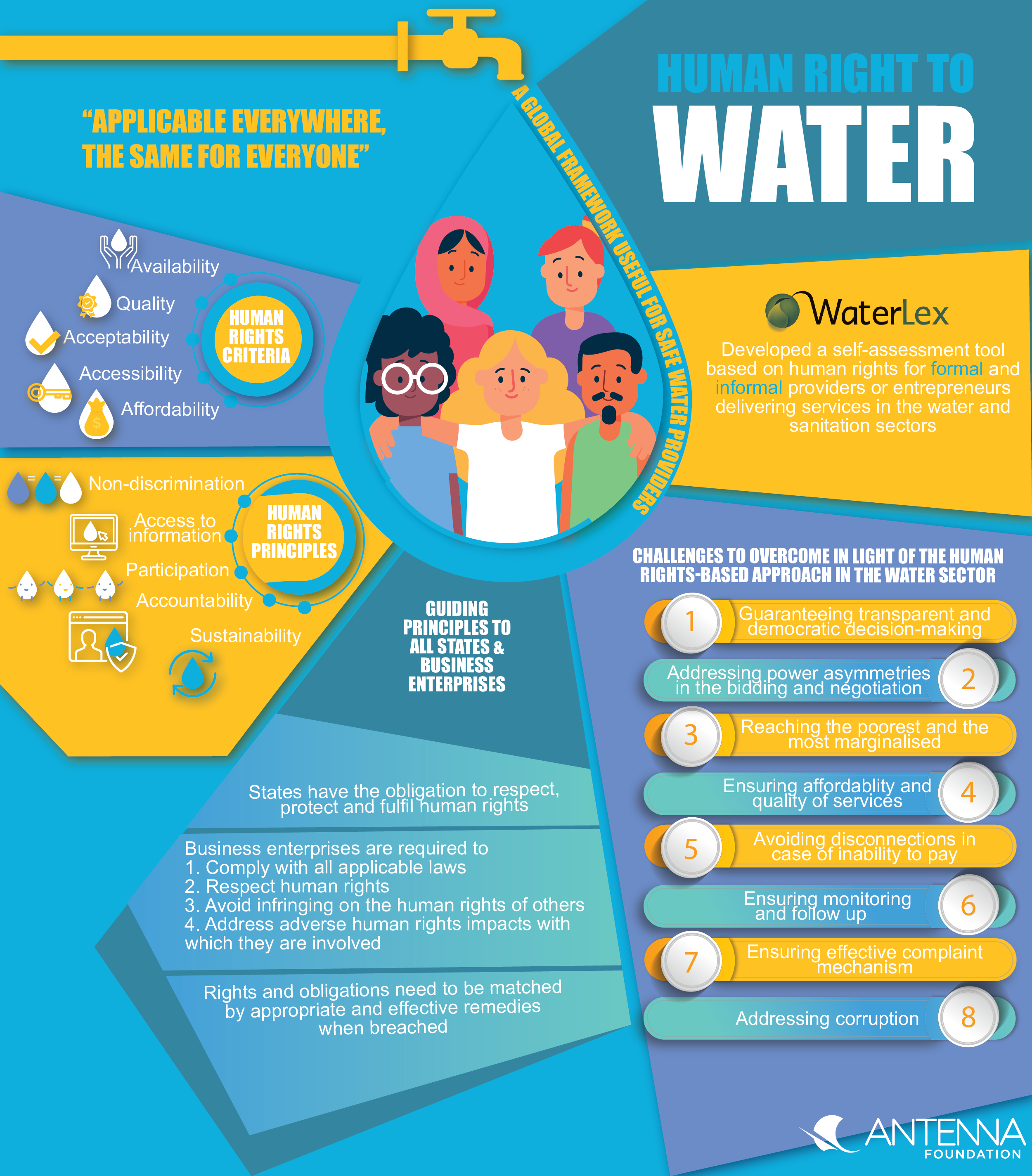Executive Summary

In 2010 the UN General Assembly declared the right to drinking water and sanitation (HRWS) as essential to the full enjoyment of life and all human rights. State and non-state actors have a basic responsibility to respect human rights, also the HRWS.
This factsheet explains what the human right to water is and provides a self-checklist for assessing an enterprise’s compliance with HRWS.
The case study of FANSA showcases how the self-checklist has been used and applied in India and Nepal. It provides insides of what aspects are important in order to adapt the checklist to a particular context.
What is the Human Right to Water and Sanitation?
Human rights are the inalienable fundamental rights to which each person is inherently entitled. Human rights are conceived as universal (applicable everywhere) and egalitarian (the same for everyone). They embody the basic standards without which people cannot realise their inherent human dignity.
In 2010 UN General Assembly declared the right to drinking water and sanitation as essential to the full enjoyment of life and all human rights. Human rights obligations related to access to water and sanitation are included in different human rights treaties and entitle everyone to sufficient, safe, accessible, culturally acceptable and affordable water and sanitation services for personal and domestic uses, and which are delivered in a participatory, accountable and non-discriminatory manner (UNITED NATIONS, 2010).
Human rights criteria (availability, quality, acceptability, accessibility and affordability) and human rights principles (non-discrimination, access to information, participation, accountability and sustainability) shape the content and scope of the right and guide its implementation process. All of these elements give meaning to the human right to water and sanitation and must be taken into account for its implementation.
To comply with HRWS is challenging as the principles cover a broad area of aspects. Catarina de Albuquerque (special rapporteur on HRWS) and her team have identified some major challenges to overcome in light of the human rights-based approach in the water sector (UNITED NATIONS, 2010):
- Guaranteeing transparent and democratic decision-making
- Addressing power asymmetries in the bidding and negotiation process
- Reaching the poorest and the most marginalised
- Ensuring affordable services
- Avoiding disconnections in case of inability to pay
- Ensuring the quality of services
- Ensuring monitoring and follow up
- Ensuring effective complaint mechanism
- Addressing corruption.
Why do water providers and HWTS social enterprises have to comply with the Human Right to Water and Sanitation?
The United Nations Human Rights Council (2011) endorsed the Guiding Principles on Business and Human Rights: Implementing the United Nations ‘Protect, Respect and Remedy’ Framework. These Guiding Principles apply to all States and to all business enterprises, regardless of their size, sector, location, ownership and structure.
These tripartite Guiding Principles recognise that (RUGGIE, 2008):
- States have the obligation to respect, protect and fulfil human rights;
- Business enterprises are required to comply with all applicable laws and need to respect human rights. They should avoid infringing on the human rights of others and should address adverse human rights impacts with which they are involved; and
- Rights and obligations need to be matched by appropriate and effective remedies when breached.
This endorsement implies on water operators and household water treatment solution (HWTS) producers to comply with local laws and regulations and to respect human rights, including the right to access to safe drinking water and sanitation. The distinctive responsibilities of companies in relation to human rights are summarised under the concept of ‘due diligence’: Companies are required to exercise due diligence (“this concept describes the steps a company must take to become aware of, prevent and address adverse human rights impacts” (RUGGIE, 2008)) in relation to human rights while operating.
| BOX: Challenges of complying with all facets of HRWS Private enterprises may contribute to the realisation of the human right to water and sanitation, but the activities of service providers may also potentially result in abuses of the right to water and sanitation. The key problem of complying with the HRWS is to deliver water to all at an affordable price but also being viable and cover all costs related to this delivery. There may be trade-offs between the different goals stated above and it is very challenging to deliver safe water at affordable prices especially to inhabitants at the bottom of the pyramid (BoP) (see also tool on value capture). Being inclusive and reach the poorest of the poor is even more challenging and subsidising the prices - for everybody - to a level that all can afford is not a solution either: selling safe water at a price below the cost is not sustainable and will lead to a disruption once subsidies dry out. Water pricing is complex and consists of all kinds of conflicting goals (BRÜHLMANN, 2016). There are different potential trade-offs with regard to pricing water adequately to ensure affordability, acceptability, accessibility and inclusion and at the same time ensure financial sustainability. Insights from different organisations operating at the BoP have shown that this is challenging and requires the development of low-cost technologies, building efficient and effective supply chains, designing aspirational products and services and come up with solutions to also target the most socio-economic disadvantaged segment of the BoP. Since ability and willingness to pay is still low and hence price elasticity high enough revenues can only be collected by selling high volumes of water or HWTS. In order to overcome such issues innovative ideas can help. Proven methods do include cross-subsidising different products combined with a clear product segmentation or a product segmentation as such. Examples could be chlorine bottles at a lower price for water disinfection and a fancy bottle for vegetable cleaning sold at a higher price. The different prices and per unit revenues can support the viability of a business model while complying with the human right to water. “Joint efforts by the public and private sector are necessary and NGOs as well as government agencies can complement market-based approaches by creating an enabling environment and raise awareness for the health benefits of safe water.” (BRÜHLMANN, 2016). Interesting as well, is that being sustainable is an important dimension of the Human Right to Water and not affordability only. |
For whom is HRWS tool crucial?
Recognising access to safe drinking water and sanitation as a human right means that everybody is entitled to this right. It is governments that are primarily responsible for the realisation of the human right to water and sanitation. In order to assess the status of compliance with the human right to water the self-check assessment tool has been designed for private enterprises but can also be useful for NGOs and other safe water initiatives. With the help of the checklist enterprises are able to identify gaps in the enterprise’s behaviour and culture towards the progressive realisation of HRWS.
Subscribe here to the new Sanitation and Water Entrepreneurship Pact (SWEP) newsletter. SWEP is a network of organizations joining hands to help entrepreneurs design and develop lasting water and sanitation businesses.
How can the compliance to Human Right to Water and Sanitation be assessed in practice?
The concept of progressive realisation constitutes recognition that full realisation of these human rights will often not be achieved immediately. The realisation shall be implemented progressively over a certain period of time. However, core obligations will need to be ensured immediately, such as non-discrimination and the guarantee of a minimum essential amount of water that is sufficient and safe for personal and domestic uses to prevent disease level of water (enough water to prevent dehydration and disease). In order to check whether a water service provider or HWTS producer/ distributor is complying with the HRWS and the Guiding Principles on Business and Human Rights, WaterLex has developed a comprehensive self-assessment checklist, the so-called HRWS business guidelines checklist (2014):
The objective of this checklist is to provide a self-assessment tool based on human rights for informal providers or entrepreneurs delivering services in the water and sanitation sectors (water trucks, standpipes, kiosk operators, small-scale water delivery services, household water treatment systems, and others). This checklist aims to assist these entrepreneurs to comply with human rights.
By encouraging water suppliers to comply with the Human Right to Water and Sanitation, their positive impact improves, including an increase of their economic and political power (integration in larger development frameworks, possibility to partner with larger institutions, and other benefits).
HRWS business guidelines checklist
To assess your company’s compliance with the Human Right to Water and Sanitation and on the improvements needed, tick the boxes of the checklist for operation of services and decision making, which can be downloaded here.
The use and application of the outlined checklist is showcased in the subsequent case study of FANSA in Nepal and India.
Pricing of Water and the Human Right to Water
Protect, Respect and Remedy: a Framework for Business and Human Rights
The Human Right to Water and Sanitation
Integrating the Human Right to Water and Sanitation in Development Practice
On the right track - Good Practices in realising the rights to water and sanitation
Blue future – Protecting water for the people and the planet forever
In this book, Barlow draws on her extensive experience and insight to lay out a set of key principles that show the way forward to what she calls a “water-secure and water-just world.” Focusing on solutions, she includes stories of struggle and resistance from marginalized communities, as well as government policies that work for both people and the planet.
BARLOW, M. (2013): Blue future – Protecting water for the people and the planet forever. URL [Accessed: 20.06.2018]Towards realizing the Human Right to Water and Sanitation for all: Private Sector Responsibilities in Creative and Practical Models
Is the UN turning its back on the human right to water?
'Water is a human right ... but it can have a price'
How to use the UN Guiding Principles on Business and Human Rights in company research and advocacy - A guide for civil society organisations
Access to water and sanitation: analysis of the Mexican legal framework from a human rights perspective
Right to Water
Comprehensive information and resources Human Right to Water and Sanitation.
Human Right to Water and Sanitation Toolkit
Human Right to Water and Sanitation Toolkit from United Nations Human Rights Office of the High Commission (OHCHR) provides interesting methodologies, tools and reports on Human Right to Water and Sanitation in practice.
WaterLex
WaterLex is an NGO based in Geneva, Switzerland, contributing to sustainable water governance and management through a catalytical cycle of research, knowledge training and legal products. Working as facilitator among Public Sector, Private Sector and Civil Society stakeholders. WaterLex legal database is a database on water regulations of countries around the globe.


